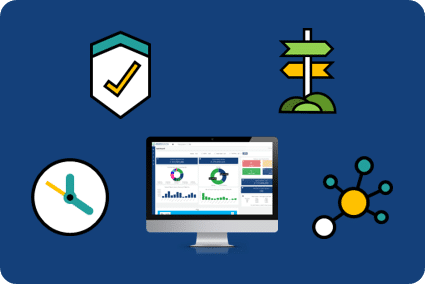BLOGS
3 Signs That Indicate A Business Is Ready For Lease Accounting Software

If your business is growing thanks to the many benefits of using lease agreements to acquire assets, managing your portfolio is reason enough.
But if you look at these three signs and feel any of them apply to your business, it’s most definitely time to consider lease accounting software solutions;
- Your business has such a large lease portfolio that managing it detracts management time away from other tasks.
- The changes which are due as part of IFRS 16 will make the day to day management of your portfolio too sizeable whilst trying to achieve compliance with the new standard and trying to minimise financial impact of the changes.
- You are unsure where all your lease documentation and data is stored and who is responsible for it, and you are unsure of how your lease agreements will be accounted for under the new accounting standards.
The Signs Explored In More Depth & How Lease Accounting Software Helps
1- Lease Management Is Too Time-Consuming
A company’s lease portfolio can be judged as too time consuming if the amount of management time diverted to organising it is costlier than the benefits gained from the lease agreements themselves. Granted, this can be hard to quantify but some symptoms to look out for include: a feeling of constant lease related firefighting (whilst solving one issue like a renewal or renegotiation, other issues arise related to different agreements), agreements becoming more and more costly, penalty charges and auto-renewals being evoked, other responsibilities being neglected in other aspects of the manager’s role.
Lease accounting software can help alleviate this issue by creating a level of automation and giving companies an early warning system for upcoming issues. Management attention can be directed to the most pressing issues rather than spending time analysing and organising the portfolio administration, which only serves to waste time better spent on the pressing issues.
By using a cloud-based lease accounting software tool, you can also tap into a wealth of lease industry experience and securely be assured of the true value of your lease agreements. Using the software’s knowledge to your own advantage will result in a more cost-effective lease portfolio that needs less management time too.
2- Managing The Upcoming IFRS 16 Changes To Lease Accounting
With the biggest shake-up to lease accounting practices and standards only a matter of months away, your business should already be well on with the process of mitigating the risks involved with your financial reports and planning on how to capitalise on the opportunities that will arise. Sadly, many businesses have neglected to do this purely because other more pressing issues have taken precedence. Whilst this is most understandable, it has left many companies in the unfortunate position that what was a big enough task already, becoming compliant and managing everything involved the with lease accounting changes, has become unmanageable without the help of lease accounting software.
Innervision’s own software, LOIS, assesses your lease portfolio and helps you to become compliant and directs your attention to those agreements which need attention. This removes the risk of breaching the new standards but also makes the process of achieving compliance a lot quicker.
Such software also generates commonly needed financial reports effortlessly or you can tailor the programme to create your own original reports too.
3- Collating And Managing Lease Information
The third sign is probably the most common problem facing companies with a lease portfolio to manage. All too often, lease agreement data, paperwork and other information are scattered across different points of responsibility or even stored in different locations.
This results in collating data for reporting and analysing being a nightmare task. Also, once the lease accounting changes happen when IFRS 16 comes into force, ensuring compliance will be a second major headache.
Using lease accounting software based on a cloud system will make this process easy. Being digitally centralised means that all lease data is stored together and can be accessed by relevant employees from any location and at any time. Also, the fact that these employees are accessing the same centrally sourced files means that duplication and the use of superseded documents is removed. The whole system is online so the instance of, for example, two remote staff members downloading a spreadsheet and updating it with their own respective data and putting each back on a shared drive or server is removed.
This makes collaborative management of your lease portfolio error-free, secure and speedy.
Furthermore, the fact that your data is securely stored in the cloud means that it can be safely and confidentially analysed by the software to see that you are achieving compliance and real value.
It could be that your business model is shifting away from using leasing as a means of acquiring the use of certain assets, but this kind of software ensures you can unlock the many benefits that leasing has to offer as well as understanding and perhaps appreciating your presently leased assets
A Reminder Of Why Leasing Has Grown In Importance
The leasing industry has grown and grown over the years because more and more businesses are realising the massive benefits that using the assets of a well-managed lease portfolio bring to a business. Acquiring the use of all types of assets via lease agreements rather than a hire purchase agreement, purchasing outright via a loan or using existing capital to buy items at ticket price is the norm for many businesses.
The majority of businesses now utilise at least some form of leasing to acquire the assets they need in order to operate.
This is despite some of the widely touted negatives of using leasing as a business model for asset acquirement. For example, the assets aren’t the property of the business so cannot be used as security. And some poorly organised companies can end up paying more in a lease agreement than it would have cost to pay the initial purchase price of said asset.
That’s because these potential drawbacks are massively outweighed by the many positives that businesses can take from leasing.
The market has plenty of options for lease agreement providers, so this means that providers have to offer the best quality assets at the most competitive terms possible. This has been great news for lessees who can take advantage of such a competitive marketplace.
In overly simple terms, lessors are providing lessees with a combination of the best quality equipment at the lowest rates and most agreeable terms. If not, they’ll fall behind the competition. Thinking slightly deeper, it’s also in the interest of asset owners (the lessors) to provide complimentary servicing and certain replacement parts (two of the ‘agreeable terms’ mentioned earlier) because this can help preserve the asset’s value at the end of the agreement. Thus, protecting the lessor’s residual investment in said asset.
But the practical advantages that leasing offers to businesses who take out lease agreements for their equipment and assets are plentiful and they go beyond the fact that providers are forced to offer competitive rates and terms.
Linking to the point about the leasing market being a competitive place, a potential USP is to offer the latest specification of equipment. Even if a newer spec model is released by a manufacturer, some lessors will give their lessee the option to upgrade the asset to the improved piece of equipment or asset. This means that, if they shop around at least, companies can access the newest and highest specification equipment for a fraction of the list price.
If a manufacturing company wins a contract producing items for a client which will mean procuring some new heavy plant machinery, leasing offers usage for a planned period with a smaller financial commitment than taking out a loan to pay for the machinery outright. As well as having the added benefit of being covered by certain provider’s warranties and removing the need to sell the machinery once the contract is completed.
And this is relatable to businesses of all sizes. If an SME home building firm has been tasked with clearing a small woodland or has encountered particularly weak ground for strip foundations, for example, they might lease some plant in the short term.
A short-term lease might have higher monthly payments than repaying the loan borrowed for purchasing the plant outright, but it’s more cost effective to make many short commitments than having the asset sitting redundant for months or even years at a time.
This frees up cash and finance to be used where it might be more pressing for the business, making cash flow management more flexible and assured. There are no liabilities about the value of the asset because it is still the property of the lessor, though the lessee gets to use it exclusively and as though it were their own.
Besides these benefits, there are also others. Disposing of problematic items at the end of their lifecycle is the responsibility of the asset’s ultimate owner, not the lessee. This can save vast amounts of time and money as well as contingent liabilities.
Scaling the portfolio of assets which the company uses to suit current needs is easier under leasing than when purchasing items outright. The more agreements that two entities have with each other will typically result in more favourable terms for the lessee, as is normal business practice.
But therein lies the core reason that more and more companies are turning to lease accounting software to manage their portfolio of lease agreements. Given the numerous benefits we have discussed for lessees, it’s obvious that lessors need to protect their interests in order to generate their own profit.
Part of the lease provider’s profit comes from being able to have bigger purchasing power than an individual buyer, so they can achieve more favourable purchase prices, but part of their business model is to also capitalise on any extra opportunities. Things like automatic renewals or penalty and damage charges are a constant fear for anyone taking out a lease agreement.
So, whilst the larger the lease portfolio is, multiplies the benefits, it becomes more time-consuming and riskier to manually manage the portfolio of lease agreements. Especially when you consider the world of lease accounting is in the process of changing in the largest way known for decades.
Which brings us back to why more and more companies are using lease accounting software tools.
Using intelligent accounting software for leases minimises the risk, ensures compliance and frees up management time to concentrate on other opportunities.
Read more about why your business should consider digitising lease management/accounting and how to comply with the new standards by accessing this free, easy, in-depth guide. Press the button below.







.png)


